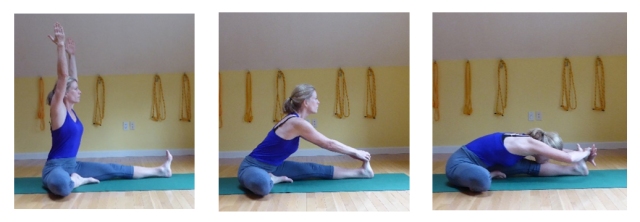Sequence for Janu Sirasana indicating one or two linking actions for each asana.
- Tadasana – Lift and spread the front of the chest, lift up through the side ribs. (vertical extention)
- Urdhva Hastasana – Roll the outer upper arms toward the inner arms. Draw the shoulders down away from the ears and in toward the spine. Lift up through the sides of the trunk.
- Vrksasana – (bent leg action) Lengthen the inner groin to the inner knee and draw the outer knee back into the outer hip (looping action). (arm torso action) Roll the outer upper arms toward the inner arms. Draw the shoulders down away from the ears and in toward the spine. Lift up through the sides of the trunk. (vertical extention)
- Parighasana bent leg – (bent leg action) Lengthen the inner groin to the inner knee and draw the outer knee back into the outer hip (looping action)
- Virabhadrasana II into Utthita Parsvakonasana (bent leg action) Lengthen the inner groin to the inner knee and draw the outer knee back into the outer hip (looping action).
- Adho mukha svanasana – Roll the inner upper arms to the outer arms. Draw the shoulders down away from the ears and in toward the spine. Lift up through the sides of the trunk.
- Parsvottanasana – concave – Draw the chest forward, extend through the sides of the body, lift and spread the front of the chest.
- Parsvottanasana – go down – keeping the actions of Parsvottanasana concave, keeping length in the sides of the body and front body as you move down.
- Padangusthasana – Pull up through the arms. Draw the body down keeping the length in the sides of the body.
- Baddha konasana – Lengthen the inner groin to the inner knee and draw the outer knee back into the outer hip (looping action). Roll the inner legs to the outer legs.
- Upavistha Konasana – Extend through the heels. Press the thighs firmly down, draw the knee caps up.
In Janu Sirsasana students tend to shorten the front body, round the back, and lift the shoulders up by the ears instead of drawing down and into the back. Tadasana, Urdhva Hastasana, Adho Mukha Svanasana, Parsvottanasana, Padangusthasana teach the student to lengthen the sides of the body evenly (vertical extention), lift and spread the front of the chest and draw the shoulders down and into the back. Vrksasana, Parighasana, Virabadrasana II, Utthita Parsvakonasana, Baddha konasana, Upavistha konasana teach the action of the legs.
